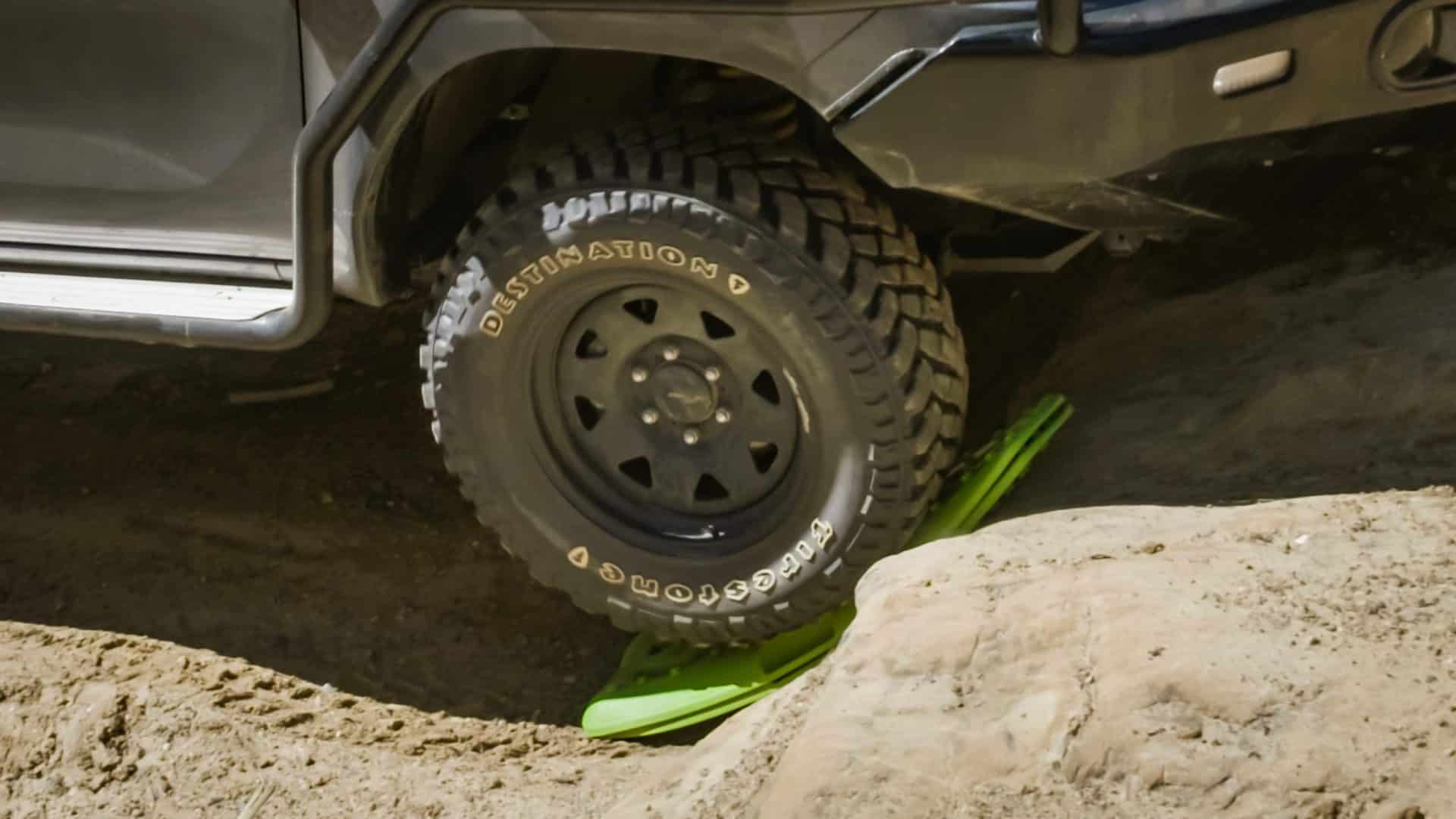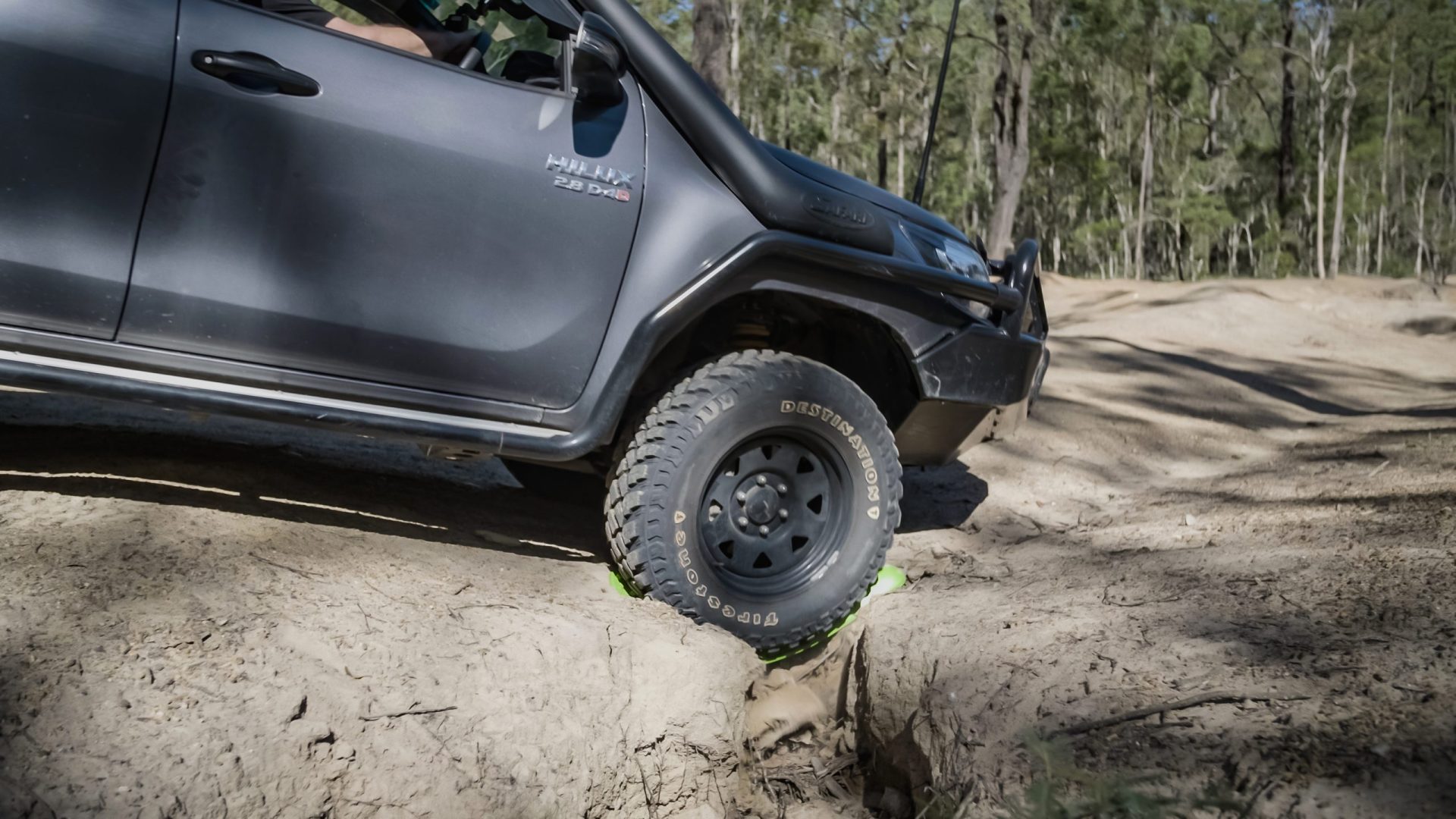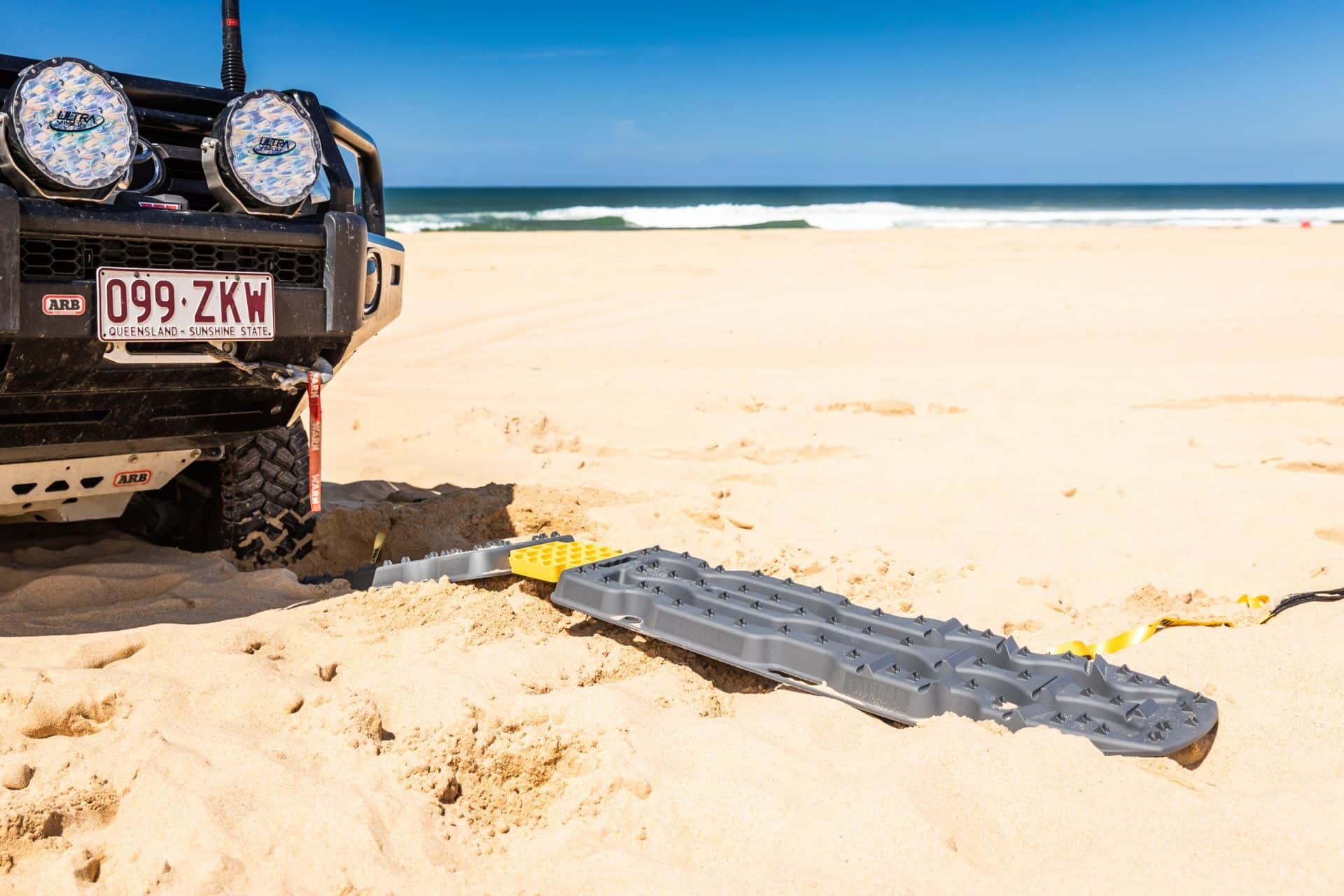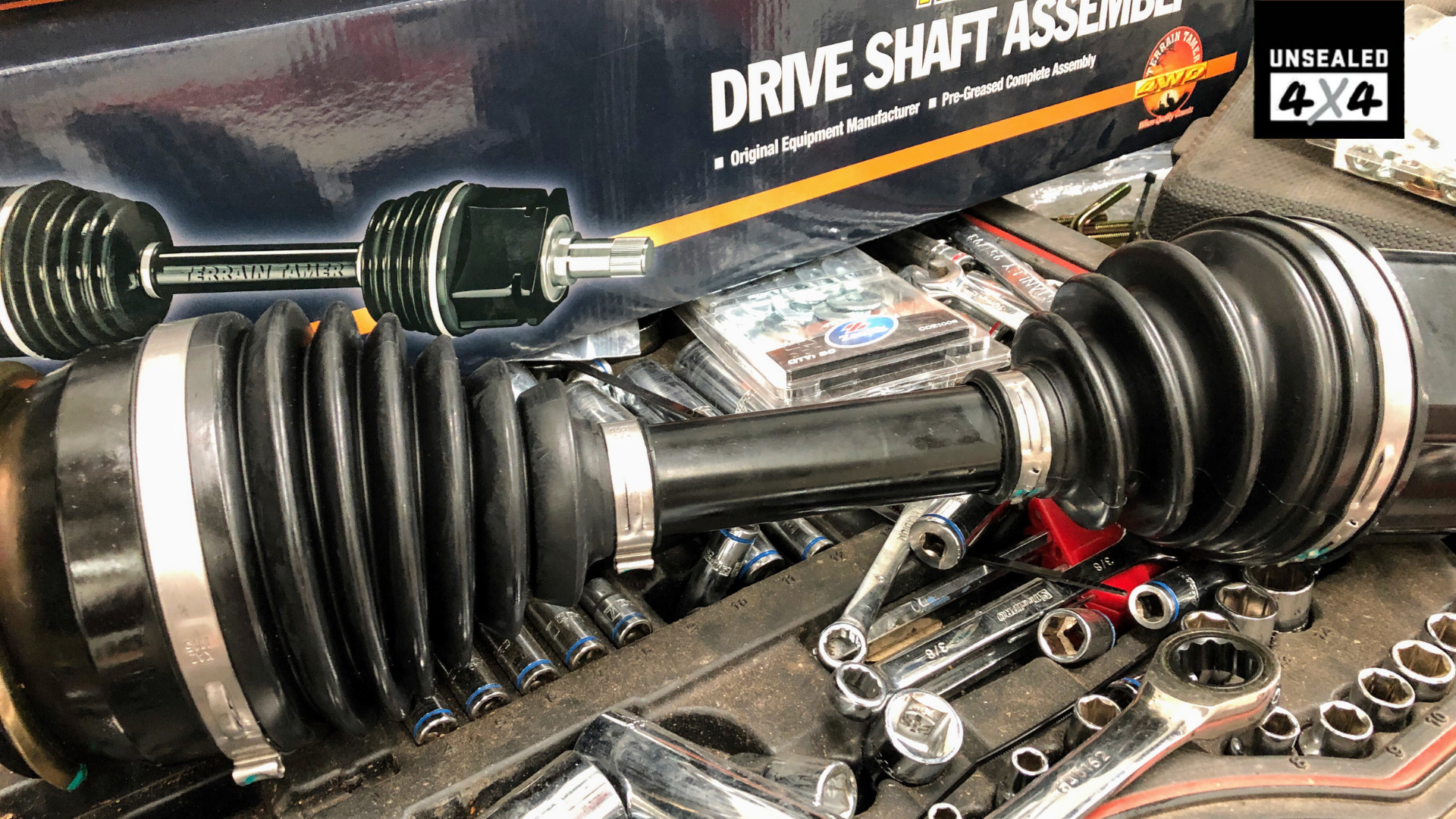Pick a recovery board, almost any recovery board and the design is largely the same…not these ones. Check out our Exitrax Recovery Boards Review.
Recovery boards are no new thing, and up until now, their design and technology has remained essentially the same. The new Exitrax by the Mean Mother team have taken a different approach, launching a new recovery board in an over saturated market, changing up the design, and the science behind the board itself. Yes, science. So, have they nailed it, let’s find out.

So, what’s so different about these new Exitrax?
At first glance they appear similar to any other recovery board on the market, yet they are just that much different. See, instead of having the angled area on top of the board, so you need to drive up onto the board proper, these boards have the curve underneath.
What this does, is allows you to be driving on the same plane throughout the length of the board, instead of having to drive up a ramp. Think of it like this, If you’re pushing the board in at a 45° angle, the extra 15° ramp at the front means you’ve got to climb the first 10 or so inches at 60°. With gravity working against us, this puts more stress on your four-wheel drive and will make it just that much harder to get a grip on the board. Starting off and continuing on the same plane (in theory) removes all of that. Plus, if you dig out just enough to get them under your treads, the board will roll over that nice curve on the bottom a lot easier than a more defined angle change like some other boards on the market.
Less is more… really
The Exitrax also go for a ‘less is more’ design with their lugs, nodules, or ‘bitey-bits’, if you will. Think about the old trick of laying down on a door of nails, got 10,000 nails supporting you, you get a prickly back, and a wicked party trick. Lay on a door with just 10 nails, and you’ve got 10 holes, and a trip to the hospital, but still a wicked party trick nonetheless. What this means in the real world, is that you’ve got more chance to get a couple of the nodules between your tread blocks, and them biting, compared to having many nodules, and as your tyre rotates on the board, it not finding one to slot into a tread block gap, but just sitting on top of them. This is where you wheels will start to spin. On the underside of the board, the entire length has ground engagement points which will bite into whatever they’re placed on, and limit the chance of them getting spat out the back of the four-wheel drive when you gain purchase on them. Then, in the 1110 and Ultimate you’ve also got cross-cleats which maximise traction again, but we’ll talk about further down the article.

They’re LIGHT
First thing you’ll notice when playing with these, is how light they are. It was a point of concern for me; how could they be as strong or solid if they were lighter? We’ll look at that below, but the other thing that jumps out at you, is the carry handle that they have in the side of the board is balanced perfectly. To the point that you can carry them one fingered, and they don’t try to spin out of your hand.
Interestingly enough, the team even have a bunch of international patents pending on the design and look of the board, and how they work, so it’s not just a knock off of something else; proper thought has gone in to these things. The Exitrax are also completely designed in Australia, and are made over the little ditch in New Zealand (locally pronounced ‘Un-Zud’).
There’s a lifetime warranty
Bear in mind, if you spin wheels on them, or abuse them that warranty is limited; but that’s a pretty standard clause in any real warranty fine print. From there, each of the different model of Exitrax has different features which we’ll look at now, then we’ll get into the testing we did, and how they fared.
What’s different in the models?
930: The 930 is the baby of the lot. It’s the shortest at 930mm long and has just the nodules that run along the top, and the ground engagement lugs on the bottom. They’re made from polypropylene and according to the team at Exitrax, absolutely shine in the sand. They’re short enough to fit across the back of both smaller soft-roader beach rigs, and the massive off-road wagons and dual-cabs that travel anywhere we’re silly enough to point them.
The 930 comes with a set of leashes out of the box, and is marketed toward the more novice four-wheel driver, or punters who just head up to the local fishing haunt with their four-wheel drive. This is due to their price, and they don’t have some of the features the more aggressive and expensive options do. They also come in both green and black, however there’s talk of adding more colours to the range. RRP: $139

1110: The 1110 is the halfway board of the Exitrax. It’s made from the same polypropylene as the 930, and has the same nodules on top, and ground engagement lugs on the bottom, however is 1110mm in length, and also features three cleats to the top of the board. These cleats are basically an angry cross bars that sit toward the front of the board that will assist with grabbing initial traction on the board, and get you moving. They’re for those of us with a touch more experience, that do put our rigs in some silly places, but up to our armpits in mud is not an everyday occurrence. As with the 930, they come with a set of leashes out of the box and are available in both green and black. RRP: $179
The Ultimate: Not just a clever name, the Ultimate is the granddaddy of recovery boards. They’re made from reinforced nylon and feature a different style of top nodule specifically made with the tread blocks of muddies in mind, and they’re the longest of the lot at 1150mm. These puppies have nine cleats that run across the boards, the front outer four at angled back near to the 30° sweep that the outer lugs on your average mud-terrain tyre will utilise, to allow the tyre lugs to bite into them. From there, there are the ground engagement lugs on the bottom to gain purchase in the mud, plus they are also compatible with the Exilinks, which we’ll talk about just below. These fellas are made with the expectation that you’re an absolute four-wheel drive enthusiast. Running bog holes, driving the proper challenging tracks, and driving up beaches and dunes into the great unknown is what you live for. So far, they are available in both gunmetal and black-grey. RRP: $249
The accessories
The Exitrax are available with a couple of accessories to go along with them. You’ve got the standard leashes, which each set of boards comes with, then you’ve got a universal carry bag (which other branded boards will fit in too), that you can get as an extra. RRP $24.95
The most interesting accessory is the Exilink plate. The Exilink can be used to join two Ultimate boards together (only the Ultimate have the slots to join them), so if you are using them in some particularly soft terrain, you can get a bit of momentum before falling off the end of the board back into the soft stuff. The other great thing about them is that they’re designed to sit in the underside of the Ultimate, and can be used as a jacking plate. This will make using either a high-lift, bottle jack, or even scissor jack (if you’re brave/stupid about in the bush) a piece of cake, and a hell of a lot more stable and safer. Plus it stops you pushing your jack six-inches into the mud if you happen to roll a bead off. It’s a multi-use bit of kit to get that removes an item in your kit that just has one job – a high-lift jacking plate. RRP: $59.95

How did we test them?
At Unsealed 4X4, we’re not known for taking things easy, or gently for that matter. We wanted to make this as hard a test on these new boards as we could; cause why make it easy, right? We took them out and tested them in sand as a traction device, which is pretty standard type of test, then we tried to mash them into a solid rock step as a ramp-up device, and then of course we tried to fold them in half by using them as a rut-crossing device. It’s worth noting here that we didn’t dig the rear tyres out on any of the tests, despite the fact in a proper bogging you would. Let’s get into the specifics of the jobs we pushed them in to.
Sand…
In the sand, we bogged the HiLux in reasonably soft stuff, on about a 20° incline near the frontal dunes. We did this for two reasons, firstly because that’s where a lot of people get stuck, and secondly because I figured I could reverse out of there if everything went pear-shaped. That said, we didn’t dig out the rear tyres as you normally would, to put the Exitrax through as hard a test as we could manage. We only let the tyres in the HiLux down to 22psi too; if you’ve travelled Stocko Beach, you’ll understand it’s usually a beach you head to 14psi as a starting point. Don’t get me wrong, you’re supposed to use these at low tyre pressure, but I wanted to get proper bogged, and absolutely do the wrong thing to start with.

930: Across the sand, the 930 were amazing. They happily gripped up to the Firestone Destination MT2’s I run on the HiLux and pulled me out of a solid bogging rather easily. They bit as they should, and didn’t get spat out from under the tyre when I started to apply a bit of right foot. In bogging the HiLux, we were just shy of being bellied out but still lost all forward movement. They worked exactly as they should, so it’s a solid pass for me.
1110: The 1110 in the sand worked again, just as they should. We bogged the HiLux to its front bash plate, and the rear diff was just sitting on the sand. We dug out a touch of the front tyres and inserted the Exitrax to the tips were just under the tyre tread. Again, I was able to gain purchase quickly and easily, with no tyre slip. It was here that I noticed the lack of a top ramp on the boards; instead of expecting to feel the HiLux climb then level out as you would on another board, it was a nice linear drive from go to woah.
Ultimate: Again, we couldn’t get them to falter. This time we were absolutely cross-axle bogged, sitting firmly on the diff, gearbox cross member and bash-plate. Just about as bogged as you could get in sand. This time, the wheels slipped a touch as they gained traction (which I’m putting down to user error – not pushing them far enough under the front tyres), and we also engaged the Exilinks to link the four boards we had with us together. They worked exactly as designed and let me run along the boards before dropping off into the softer sand again.
Sand conclusion: All in all, the entire range of boards worked on sand exactly as they were supposed to, dragging me up and out of the sand, and got me moving again. Even without removing sand from in front of the rear tyres, as you normally would if you were proper bogged.
Track-building/step climbing…
Next on the list of ways to test the Exitrax, was track building. Out the back of my place, we’ve got a nice little quarry that has a couple of step-ups that have more rubber laid down from people trying to climb them than you can poke a stick at. We figured it was a great place to test them for their track-building and step climbing abilities.

930: Being the shortest board, I had my concerns with how well the 930 would do. We placed the boards initially double stacked, and backwards at about a 60° angle up the step. I wanted to test if the HiLux could climb up the back of the board to start with and if it would spit the board out. I’m happy to report, the HiLux climbed up beautifully, without an issue. One of the boards was spat out a touch as we climbed, and took a touch of meat off the bottom lugs from the weight of the HiLux sandwiching them between a tyre at 35psi and solid rock. Otherwise, worked exactly as intended.
1110: The 1110 did exactly the same; we put it backwards, but this time only used the one board, instead of two stacked. Reason for this, was if you are going to use them to get yourself up a step, or out of trouble, chances are you’ll need one under each front wheel. Surprisingly, despite being longer (therefore more weight between a wider point – remember physics from school??), and only using the one, the 1110 didn’t buckle. It did however bend with the weight, but came back to straight once the weight was removed. It took a touch of meat off the ground engagement lugs on the bottom but otherwise survived without a bend, or breakage.
Ultimate: This is where I thought we’d change it up a bit. We put the board with the thinnest part to the bottom to see if we could curl the thinner end over, and perhaps make it slide out as it didn’t have the hard formed end to bite into the base of the step. Despite my attempts at trying to break these things, or make them fail, I just couldn’t make it happen. There’s also the fact that the Ultimates are the longest, at 1150mm, and that they are made from nylon, as opposed to the polypropylene of the other two. Same deal, worked exactly as they should have, and just took a bit of bark off the bottom lugs.
Track-building/step climbing conclusion…
Despite our best efforts, these things just worked. And worked bloody well. Interestingly, there’s nothing in the material we’ve seen on these, saying you can (or should) use them for track-building/step climbing. They do say if you use them against a solid surface like rock or hard earth, if you damage the bottom (like we did), you’re not covered by the lifetime warranty on them, which is fair enough.
Rut/hole bridging…
Last on the list of tests, was rut/hole bridging. We really wanted to get these little buggers to bend properly and see if we could actually break them. This is where they each responded differently, and you can really tell the differences in the boards. But, spoiler alert, we couldn’t destroy them despite our best efforts.
930: We started with the little board that could; the 930. We used it to bridge a washout that was about 400mm across. I just want to point out here that we put a lot of faith in this little jigger. Had it all gone pair-shaped there was a fair to good chance the HiLux could have ended up on its lid. Once we lined it up and put the HiLux on it, the board bent something fierce, and once we were off it, kept a little bit of a bow; about 10° off true in the middle. But, it didn’t break, snap, or otherwise explode. Yep, I was disappointed too, especially as how I like breaking stuff when I’m testing things!
1110: The 1110 bridged the same gap, but a touch of the washout had crumbled away with the weight of the HiLux on the 930 test. That said, this board too bent, yet it still retained the purchase with the bottom ground engagement lugs on the dirt and didn’t just fold up and fall into the hole. It held the weight a little better, and the length of it over the 930 helped to keep the edges up out of the hole.
Ultimate: The Ultimate, being nylon and the longest, was the one that worried me most. Due to the weight of the HiLux, and the extra tension over the board due to the straight downward perpendicular pressure. It bent, but not as severely as the other two, and still retained traction on the ground either side of the washout. The test did actually bend the board after it was out of the hole, yet came back nearly to true; a testament to the nylon used, it’s good stuff.
Rut/hole bridging conclusion
Each Exitrax held up well enough to be able to be used as a bridging device for either ruts, or a washout, or using as an extra board in a dodgy old bridge (Old Tele Track, anyone?). They certainly bent and flexed with the weight of the HiLux rolling over them, yet all still gained purchase and didn’t just fold in half, and fall into the hole. All in all, they did well, but the Ultimate is easily the best suited to bridging duties. That said, we expected that as most novice or gentle four-wheel drivers will seldom find themselves in a position to use them for bridging. Those of us who can’t help but put our four-wheel drives in stupid places every chance we get may well need them to work as a bridge. Horses for courses, right?

So, what do we think?
At the end of the day, we’ve thrown some pretty heavy-duty stuff at these boards, some of which they were never intended to do (and will void your warranty). But, they handled it well enough as a one-off. I think if you used them every day for bridging and track building, they’d last a while, but you’d knacker them eventually. For what they’re specifically designed for, getting you out of a bogging, they’re perfect; they work well and do exactly what they need to do.
As a bit of a disclaimer, I’ve never been one for traction boards. I’ve always either had a winch, or a mate to get me out of the stupid places I’ve put the ‘Cruiser, and now the HiLux, or I would just pick and choose my lines to not need them (or throw the lockers on). I’ve always thought of them as a ‘shiny accessory’ to put on your four-wheel drive to look cool… But after taking these things out into the world and putting my four-wheel drive in a situation where I had to use them, has proven to me they can and are so much more than just a fashion accessory for your four-wheel drive. That said, they do have their place especially making things easier and safer when recovering. You’ve not got snatch loads or taught winch ropes to have to worry about.
So, if and when you’re in the market for a set of recovery boards, or looking to replace your old busted up ones, I’d absolutely spend a bit of extra time having a look at the Exitrax. I reckon I’m going to try to score this set we tested and bolt them to the top of the HiLux… Now to see if they come in hot-pink with sparkles.










